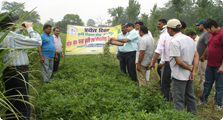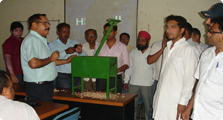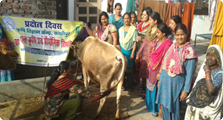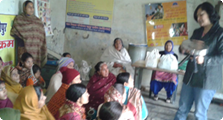General Profile of U.S.Nagar
- Useful Land : 286760
- Total Cultivated Land : 264848
- Forest : 100798
- Cultivated Land in Kharif : 133331
- Cultivated Land Rabi : 113067
- Cultivated Land Zaid : 18450
Major farming systems/enterprises (based on the analysis made by the KVK)
| S.N. |
Farming system/enterprise |
| 1 |
Agriculture and animal husbandry / fisheries |
Description of Agro-climatic Zone & major agro ecological situations (based on soil and topography)
Soil Type/s
| S.N. |
Agro-climatic Zone |
Characteristics |
| 1 |
Tarai and Bhabar |
Total geographical area of 3055 sq. km., soil alluvial in nature, low to medium in phosphorus, low to medium in potassium and low in organic matter. Main crops grown- Rice, wheat, sugarcane and pulses. Average annual rainfall-1433.4mm, Minimum temp. 3-50C, Maximum temp. 39-410C. Irrigated area- 80%, Agri-export zone of basmati rice, litchi, floriculture and medicinal and aromatic plants. As per the recent report of NBSS and LUP, average pH of the soils is increased up to 8.2. |
Topography
| S.N. |
Agro Ecological Situation |
Characteristics |
| 1 |
AES –I (Blocks covered- Khatima and Sitarganj) |
Soil loam and sandy loam, water logged condition, prone to flood, soil fertility medium, medium to deep soil, irrigated situation, and Paddy-Wheat and Paddy-Sugarcane crops grown. |
| 2 |
AES –II (Blocks covered- Bazpur, Gadarpur and Rudrapur) |
Soil loam to clay loam, poor drainage, soil fertility medium to low, deep soil, irrigated situation, Paddy-Sugarcane, Paddy-Wheat, Paddy-Pea/Paddy-Potato, Paddy-Barseem crops grown. |
| 3 |
AES –III (Blocks covered- Jaspur and Kashipur) |
Soil sandy loam to clay loam, drainage problem, soil fertility low, medium to deep soil irrigated situation, Paddy-Wheat, Paddy-Sugarcane-Lahi-Wheat, Paddy-Sugarcane – lahi crops grown. |
Soil Type/s
| S.N. |
Soil Type |
Characteristics |
Area in ha |
| 1 |
Loam, sandy loam and clay loam |
Soils of district U. S. Nagar is alluvial in nature, low to medium in phosphorus, medium to high in potassium and high in organic matter. Deficient in zinc, rich in calcium carbonate. Drainage of soil is imperfect and water logging is great threat to the field crops. |
Not quantified |
Area, Production and Productivity of major crops cultivated in the district (2014-15)
Field crops including oil seeds and pulses and vegeatbles
| S.N. |
Crop |
Area (ha) |
Production (MT) |
Productivity (Qtl /ha) |
| 1 |
Paddy |
98565 |
310108 |
31.46 |
| 2 |
Wheat |
95515 |
365049 |
38.22 |
| 3 |
Sugarcane |
41372 |
234200 |
566.0 |
| 4 |
Lentil |
212 |
170 |
8.04 |
| 5 |
Mustard |
5003 |
4277 |
8.55 |
| 6 |
Potato |
589 |
5565 |
113.01 |
| S.N. |
Crop |
Area (ha) |
Production (Qtl) |
Productivity (Qtl /ha) |
| 1 |
Pear |
81 |
710-00 |
8.77 |
| 2 |
Lemon |
1560 |
3750 |
2.40 |
| 3 |
Mango |
3740 |
32186 |
8.61 |
| 4 |
Lichi |
280 |
75 |
0.27 |
| 5 |
Guava |
47 |
115 |
2.45 |
| 6 |
Others |
580 |
1615 |
2.78 |
| S.N. |
Spices |
Area (ha) |
Production (Qtl) |
Productivity (Qtl /ha) |
| 1 |
Turmeric |
115 |
1005 |
8.74 |
| 2 |
Chilli |
180 |
1325 |
7.36 |
| 3 |
Corriander |
160 |
255 |
1.59 |
| 4 |
Fenugreek |
90 |
600 |
6.67 |
| 5 |
Garlic |
165 |
1008 |
6.11 |
| 6 |
Ginger |
275 |
5415 |
19.69 |
| 7 |
Big Cardamon |
15 |
25 |
1.67 |
| 8 |
Others |
25 |
130 |
5.20 |
| S.N. |
Vegetables |
Area (ha) |
Production (Qtl) |
Productivity (Qtl /ha) |
| 1 |
Pea |
2360 |
16369 |
6.94 |
| 2 |
Radish |
194 |
3367 |
17.36 |
| 3 |
Franchbean |
144 |
918 |
6.38 |
| 4 |
Cabbage |
394 |
6734 |
17.09 |
| 5 |
Cauliflower |
280 |
5014 |
17.91 |
| 6 |
Onion |
320 |
3500 |
10.94 |
| 7 |
Capsicum |
171 |
664 |
3.88 |
| 8 |
Okra |
492 |
5053 |
10.27 |
| 9 |
Tomato |
905 |
13763 |
15.21 |
| 10 |
Brinjal |
364 |
5625 |
15.45 |
| 11 |
Others |
823 |
7727 |
9.39 |
| S.N. |
Animals |
Population |
Production (Qtl) |
Productivity (Qtl /ha) |
| 1 |
Cow |
138730 |
|
|
| 2 |
Buffalo |
176820 |
|
|
| 3 |
Sheep |
3118 |
|
|
| 4 |
Goat |
62974 |
|
|
| 5 |
Pig |
1684 |
|
|
| 6 |
Horse/Mule |
1244 |
|
|
| 7 |
Donkey |
140 |
|
|
| 8 |
Dog |
33562 |
|
|
| 9 |
Poultry/Birds |
1227520 |
|
|
| 10 |
Fisheries (pond) |
312 ha |
8455.9 |
27.19 |
Production and productivity of livestock, Poultry, Fisheries etc. in the district
| Category |
Population |
Production |
Productivity |
| Cattle |
|
|
|
| Crossbred |
53595 |
NA |
NA |
| Indigenous |
70356 |
NA |
NA |
| Buffalo |
175905 |
NA |
NA |
| Sheep |
2157 |
NA |
NA |
| Goats |
44514 |
NA |
NA |
| Poultry |
997724 |
NA |
NA |
| Fish |
1000 |
3000 |
NA |
Details of Operational Area / Villages (2014-15)
| Name of the block |
Name of the village |
Major crops & enterprise |
Major problem identified |
Identified thrust areas |
| Khatima |
Bari Anjania |
- Sugarcane
- Paddy
- Wheat
- Pulses, Urd, Lentil
- Oilseeds, Soybean, Lahi, Mustard
- Nutrition garden
- Animal Husbandry
- Fisheries
|
- Use of traditional methods for sowing of crops.
- Non-availability of recommended varieties of crops.
- Gap in adoption of recommended dose of fertilizers and application of micronutrients.
- Lack of knowledge about the improved technologies.
- Water drainage problem.
- Non-availability of new & improved farm machineries.
- Lack of awareness & knowledge about importance of green manure & organic manure.
|
- Varietal replacement in sugarcane.
- Cost effective technology demonstration in sugarcane through introduction of IPM and IPNM.
- Quality seed production programme in sugarcane.
- Soil testing and site specific nutrient recommendation.
- Increasing crop production with high yielding varieties, IPM and IPNM.
- Introduction of organic farming.
- Introduction of mushroom production.
- Women empowerment through household food and nutrition security, value addition and processing, drudgery reduction and group (SHG) formation.
- Integrated fish farming.
|
| Sitarganj |
Karghata |
|
|
|
| Rudrapur |
Fauji, Matkota, Bhagwanpur |
|
|
|
| Gadarpur |
Majra Hasan, Kopa, Kopa Kripali, Govindpur |
|
|
|
| Bazpur |
Pipaliya |
|
|
|
| Kashipur |
Banskheri |
|
|
|
| Jaspur |
Dharampur |
|
|
|
| Ramnagar |
Udaypuri Negi |
|
|
|
Priority/Thrust Areas
| S.N. |
Thrust Area |
| 1 |
Varietal replacement in sugarcane |
| 2 |
Cost effective technology demonstration in sugarcane in sugarcane through introduction of IPM and IPNM |
| 3 |
Quality seed production programme in sugarcane |
| 4 |
Soil testing and site specific nutrient recommendation |
| 5 |
Increasing crop production with high yielding varieties, IPM and IPNM |
| 6 |
Introduction of organic farming |
| 7 |
Introduction of bee-keeping and mushroom production |
| 8 |
Women empowerment through household food security, value addition and processing, drudgery reduction and group (SHG) formation |
| 9 |
Integrated fish farming, composite fish farming |





